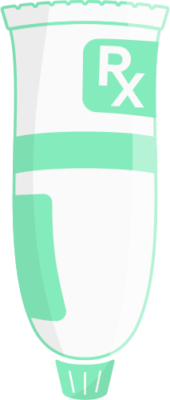What Is It?
Erythromycin is a topical antibiotic that helps slow or stop bacterial growth and reduce skin inflammation.
Efficacy
Strength of Evidence
1
2
3
4
5
Average 52% reduction in acne after 12 weeks
- Ibrahim, Z. A., Gheida, S. F., El-Halaby, A. R., Hassan, G. F. R. & Mohammed, D. A. Platelet rich plasma injection versus topical erythromycin 2% in treatment of acne vulgaris. J Dermatolog Treat 1–8 (2020) doi:10.1080/09546634.2020.1793884.
- Mazzarello, V. et al. Treatment of acne with a combination of propolis, tea tree oil, and Aloe vera compared to erythromycin cream: two double-blind investigations. Clin Pharmacol 10, 175–181 (2018).
- Mohammadi, S. et al. A survey to compare the efficacy of niosomal erythromycin alone versus combination of erythromycin and zinc acetate in the treatment of acne vulgaris. Journal of Kerman University of Medical Sciences 24, 420–430 (2017).
- Tunca, M., Akar, A., Ozmen, I. & Erbil, H. Topical nadifloxacin 1% cream vs. topical erythromycin 4% gel in the treatment of mild to moderate acne. Int J Dermatol 49, 1440–1444 (2010).
- Pazoki-Toroudi, H. et al. Combination of azelaic acid 5% and erythromycin 2% in the treatment of acne vulgaris. J Dermatolog Treat 21, 212–216 (2010).
- Plewig, G., Holland, K. T. & Nenoff, P. Clinical and bacteriological evaluation of nadifloxacin 1% cream in patients with acne vulgaris: a double-blind, phase III comparison study versus erythromycin 2% cream. Eur J Dermatol 16, 48–55 (2006).
- Mills, O., Thornsberry, C., Cardin, C. W., Smiles, K. A. & Leyden, J. J. Bacterial resistance and therapeutic outcome following three months of topical acne therapy with 2% erythromycin gel versus its vehicle. Acta Derm Venereol 82, 260–265 (2002).
- Morel, P. et al. Clinical efficacy and safety of a topical combination of retinaldehyde 0.1% with erythromycin 4% in acne vulgaris. Clin Exp Dermatol 24, 354–357 (1999).
- Glass, D., Boorman, G. C., Stables, G. I., Cunliffe, W. J. & Goode, K. A placebo-controlled clinical trial to compare a gel containing a combination of isotretinoin (0.05%) and erythromycin (2%) with gels containing isotretinoin (0.05%) or erythromycin (2%) alone in the topical treatment of acne vulgaris. Dermatology 199, 242–247 (1999).
- Bojar, R. A., Eady, E. A., Jones, C. E., Cunliffe, W. J. & Holland, K. T. Inhibition of erythromycin-resistant propionibacteria on the skin of acne patients by topical erythromycin with and without zinc. Br J Dermatol 130, 329–336 (1994).
- Dogra, A., Sood, V. & Minocha, Y. Comparative evaluation of retinoic acid, benzoyl peroxide and erythromycin lotion in acne vulgarils. Indian J Dermatol Venereol Leprol 59, 243–246 (1993).
- Graupe, K. & Zaumseil, R. P. Skinoren-ein neues Lokaltherapeutikum zur Behandlung der Acne vulgaris. in Jahrbuch der Dermatologie (Wissenschaftliche VerIagsgesellschaftBiermann, 1991).
- Habbema, L., Koopmans, B., Menke, H. E., Doornweerd, S. & De Boulle, K. A 4% erythromycin and zinc combination (Zineryt) versus 2% erythromycin (Eryderm) in acne vulgaris: a randomized, double-blind comparative study. Br J Dermatol 121, 497–502 (1989).
- Leyden, J. J., Shalita, A. R., Saatjian, G. D. & Sefton, J. Erythromycin 2% gel in comparison with clindamycin phosphate 1% solution in acne vulgaris. J Am Acad Dermatol 16, 822–827 (1987).
- Lesher, J. L. et al. An evaluation of a 2% erythromycin ointment in the topical therapy of acne vulgaris. J Am Acad Dermatol 12, 526–531 (1985).
- Shahlita, A. R., Smith, E. B. & Bauer, E. Topical erythromycin v clindamycin therapy for acne. A multicenter, double-blind comparison. Arch Dermatol 120, 351–355 (1984).
- Chalker, D. K., Shalita, A., Smith, J. G. & Swann, R. W. A double-blind study of the effectiveness of a 3% erythromycin and 5% benzoyl peroxide combination in the treatment of acne vulgaris. J Am Acad Dermatol 9, 933–936 (1983).
- Burke, B., Eady, E. A. & Cunliffe, W. J. Benzoyl peroxide versus topical erythromycin in the treatment of acne vulgaris. Br J Dermatol 108, 199–204 (1983).
- Rapaport, M., Puhvel, S. M. & Reisner, R. M. Evaluation of topical erythromycin and oral tetracycline in acne vulgaris. Cutis 30, 122–126, 130, 132–135 (1982).
- Jones, E. L. & Crumley, A. F. Topical erythromycin vs blank vehicle in a multiclinic acne study. Arch Dermatol 117, 551–553 (1981).
- Bernstein, J. E. & Shalita, A. R. Topically applied erythromycin in inflammatory acne vulgaris. J Am Acad Dermatol 2, 318–321 (1980).
- Fulton, J. E. & Pablo, G. Topical antibacterial therapy for acne. Study of the family of erythromycins. Arch Dermatol 110, 83–86 (1974).
Side Effects
Low
Low side effects and adverse reactions
Acne.org's Real World Take
Antibiotics should be used for a maximum of 3 months, provide only moderate benefit and only to some people, and may lead to side effects and strains of resistant bacteria. Studies do show they can reduce severe acne in the short term, but approach with caution and stay your own advocate.
Reviews
3.8
16 Reviews
